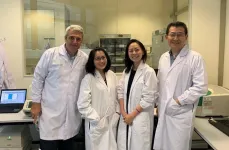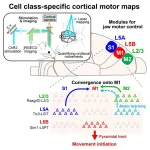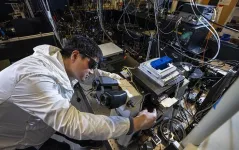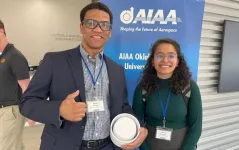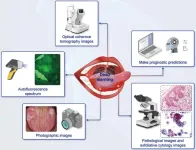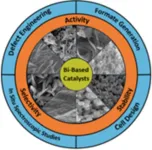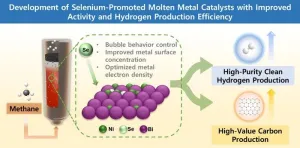New spatial mechanism for the coexistence of tree species
Hidden patterns in tree distribution stabilize biodiversity in forests
2025-02-26
(Press-News.org)
The data sets are very large: with more than 75 permanent forest dynamics plots in 29 countries worldwide, the Forest Global Earth Observatory network (ForestGEO) of the Smithsonian Tropical Research Institute (STRI) provides excellent forest inventories for investigating the dynamics of forest ecosystems and better understanding the processes that drive the structure and function of forests. On these 20-to-50-hectare plots, every single tree with a diameter not much larger than a pencil has been identified, measured and mapped every five years, often totalling more than 200 000 trees. The two UFZ researchers, Dr. Thorsten Wiegand and Prof. Dr. Andreas Huth, took a closer look at 21 of these forest megaplots, which cover a gradient from the tropical to the subtropical and temperate zones. Their international team then used the ForestGEO data to analyse the distribution of tree species in the forests and which processes are responsible for their spatial patterns. “The search for simple principles underlying the spatial structure and dynamics of plant communities is a long-standing challenge in theoretical ecology,” says first author Thorsten Wiegand, describing their research question.
For their analyses, the research team examined all individual trees with a diameter at breast height of at least 10 centimetres as found in the forests. “The closer the forest plot was located to the equator, the less likely it was that trees of rare species had a tree of the same species nearby,” says Andreas Huth. In temperate forests, in contrast, they found only slight differences between common and rare species. This results in unexpected and systematic changes in the spatial patterns from the tropics over the subtropics to the temperate latitudes. This intriguing finding immediately raised two questions: What consequences do these changes have for the coexistence of tree species and which processes cause them?
To find answers to these questions, the researchers used information on the dispersal mechanisms of the different species. “Roughly 70 to 80 percent of tree species in the tropics are dispersed by animals, but much less in temperate forests,” says Thorsten Wiegand. Another important factor is mycorrhizal fungi. This network of fungi forms a symbiotic relationship with the fine roots of the trees to benefit both organisms: The fungi supply the trees with nutrients and water, receiving glucose in return. “In temperate forests, mycorrhiza usually protect the roots of young trees in the neighbourhood of large conspecifics from pathogens or insect pests,” explains UFZ researcher Dr. Samuel M. Fischer, who was also involved in the study. In tropical forests, on the other hand, this is mostly not the case. “That's why seeds in the tropics have to ensure that they are dispersed away from their parent trees, a job mostly done by animals,” he says. The conclusion: “In tropical forests, mechanisms such as seed dispersal by animals lead to the observed patterns, while in temperate forests, the patterns are shaped by mycorrhizal fungi” says Thorsten Wiegand.
In order to better understand the consequences of the observed spatial patterns for species coexistence, the UFZ researchers used spatially explicit simulations and a novel mathematical theory. “We wanted to know under what circumstances tree species would be able to coexist,” says Andreas Huth. Stable coexistence generally requires that species that have become rare can increase in abundance again. Based on mathematical models of forest dynamics, the UFZ researchers have developed a novel formula to describe the population growth rate at low abundances. A key element of their formula is a risk factor that combines several influencing factors. The result: the more common the species currently is and the more neighbours of the same species it has, the smaller the risk factor and the higher the probability that the species can coexist. Species in temperate forests generally have a low risk factor. However, the risk factors are often greater in tropical forests, but the formula includes additional factors that compensate for this disadvantage, such as the specific spatial patterns generated by animal seed dispersal. “Overall, it turned out that species in tropical and temperate forests exhibit optimal – but contrasting - spatial structures that each promote coexistence,” concludes Thorsten Wiegand.
This newly discovered spatial mechanism now provides the starting point for further research. Thorsten Wiegand and Andreas Huth want to develop a more general theory for understanding the spatial dynamics and stability of species-rich forests as part of their research funded by an Advanced ERC Grant acquired last year. “We want to substantially expand our methods and analyses, such as by taking into account the size of the trees, the immigration of species and more detailed species characteristics, as well as by using remote sensing data,” he says. Around 2.5 million euros will be available to them for this work over the next five years.
END
[Attachments] See images for this press release:

ELSE PRESS RELEASES FROM THIS DATE:
2025-02-26
This roundup highlights a common drug that can help treat multiple myeloma, a paper analyzing the benefit of a colorectal surgery follow-up test, recommendations for implementing remote patient monitoring for care received before, during and after surgery, details on how often women with an elevated breast cancer risk are receiving enhanced screenings, and clinical trial results for a new chimeric antigen receptor (CAR) T cell therapy targeting B cell acute lymphoblastic leukemia.
To learn more about research at City of Hope, one of the largest and most advanced cancer research and treatment organizations in the U.S. with its ...
2025-02-26
SINGAPORE – NalaGenetics, a spin-off from A*STAR Genome Institute of Singapore (A*STAR GIS), will be transforming leprosy treatments in Indonesia with a nationwide genetic screening programme with their PGx1301 diagnostic kit. Set to launch in the fourth quarter of 2025, this initiative builds on a successful five-year pilot test in East Indonesia, which demonstrated the effectiveness of precision medicine in preventing life-threatening adverse drug reactions (ADRs).
As part of this programme, up ...
2025-02-26
For nearly a century, scientists have known that different parts of the human brain’s cortex control different body movements. This fundamental discovery dates to the 1930s, when neurosurgeons used electrical stimulation to map how different cortical regions correspond to different body parts.
But can these regions be further broken down into even smaller functional components? Researchers have long suspected that cortical units for specific body movements are more complex than simple patches in the cortex. Studies have identified various types of neurons stacked in multiple layers across the neocortex, but without a clear picture of how these ...
2025-02-26
A research team co-led by Lawrence Berkeley National Laboratory (Berkeley Lab), Columbia University, and Universidad Autónoma de Madrid has developed a new optical computing material from photon avalanching nanoparticles.
The breakthrough – which the team published recently in the journal Nature Photonics – paves the way for fabricating optical memory and transistors on a nanometer size scale comparable to current microelectronics. This approach offers a path toward realizing smaller, faster components for next-generation ...
2025-02-26
Colorectal cancer (CRC) is the second most commonly diagnosed cancer in China and a leading cause of cancer-related mortality. Despite improvements in treatment, the survival rate remains lower than in Western and other Asian countries due to late-stage diagnosis. Given that CRC typically develops over a prolonged period from precursor lesions, early detection and timely intervention are crucial for improving patient outcomes. However, CRC screening in China faces several challenges, including regional disparities, economic constraints, and limited public awareness. Recent advancements in non-invasive diagnostic tests, innovative imaging techniques, and ...
2025-02-26
Aerospace engineering senior Philip Wilson attended an American Institute of Aeronautics and Astronautics (AIAA) conference. Rohit Raut, a senior physics major, presented his work at a nuclear research symposium, and senior biology major Jaden Rankin had the opportunity to feature her research at an entomology conference.
These and other University of Texas at Arlington students were able to showcase their original research at major symposiums thanks to UTA’s expansion of its popular undergraduate research program that provides funding for select students to present at academic conferences.
“At the conference, I presented my work on rotating ...
2025-02-26
Oral cancer remains a serious global health concern due to its high morbidity and mortality rates, primarily caused by late-stage diagnosis. The presence of oral potentially malignant disorders (OPMDs) provides an opportunity for early intervention, as these lesions precede the development of oral squamous cell carcinoma. However, the accurate detection and classification of OPMDs remain challenging due to their diverse clinical presentations. Conventional diagnostic methods, including visual examination and histopathological ...
2025-02-26
To develop a practical fusion power system, scientists need to fully understand how the plasma fuel interacts with its surroundings. The plasma is superheated, which means some of the atoms involved can strike the wall of the fusion vessel and become embedded. To keep the system working efficiently, it’s important to know how much fuel might be trapped.
“The less fuel is trapped in the wall, the less radioactive material builds up,” said Shota Abe, a staff research physicist at the U.S. Department of Energy’s (DOE) Princeton Plasma Physics Laboratory (PPPL).
Abe is the lead researcher on a new study published in Nuclear ...
2025-02-26
The electrochemical reduction of CO2 has been recognized as a promising strategy to convert ambient atmospheric CO2 into valuable products. Bismuth-based catalysts have garnered the widespread attention of researchers due to their cost-effectiveness, low toxicity, and high natural abundance. Significant progress has been made toward enhancing the reactivity of catalyst structures through innovative synthesis techniques and engineering. Advances include the use of flow cells and membrane electrode assembly (MEA) cells to attain high cathodic current densities of over 200 mA cm-2 with superior ...
2025-02-26
Researchers in South Korea have developed an advanced liquid metal catalyst incorporating selenium (Se) to enhance the efficiency of turquoise hydrogen production.
Turquoise hydrogen is generated via methane (CH₄) pyrolysis, producing hydrogen while yielding solid carbon as a byproduct, without emitting carbon dioxide (CO₂).
A research team led by Dr. Seung Ju Han at the Korea Research Institute of Chemical Technology (KRICT) has introduced selenium-doped molten metal catalysts (NiBi, CuBi) to significantly enhance methane pyrolysis efficiency. The technology demonstrates ...
LAST 30 PRESS RELEASES:
[Press-News.org] New spatial mechanism for the coexistence of tree species
Hidden patterns in tree distribution stabilize biodiversity in forests

